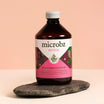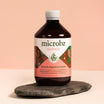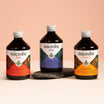Olive
Olea europaea

Family: Oleaceae
Which probiotic is it in?: Olive is a key herb in Sustain
Habit and cultivation: The Olive tree grows wild in Mediterranean countries and is cultivated throughout the Mediterranean and worldwide in countries of similar climate. The leaves are gathered throughout the year and the fruit is harvested in late summer. The leaves of the wild trees are believed to contain higher concentrations of active principles.
Actions (known for): Hypotensive, immune stimulant and hypoglycaemic.
History of Olive
Parts used from the Olive
Leaves and oil.
Constituents (bio available chemicals):
Leaf: oleasterol and leine. Oil: 75% oleic acid (a mono-unsaturated fatty acid), smaller amounts of palmitic and stearic acid glycosides.
Nutritional constituents:
Vitamin E, iron, copper and calcium.
Indications:
Severe hypertension, influenza, common cold, meningitis, herpes l and ll, hepatitis B, chronic fatigue and diabetes. Externally: dry skin, stretch marks, cradle cap, to soften ear wax and many other uses.
Dosage:
Liquid extract (1:): 25-50ml per week.




































